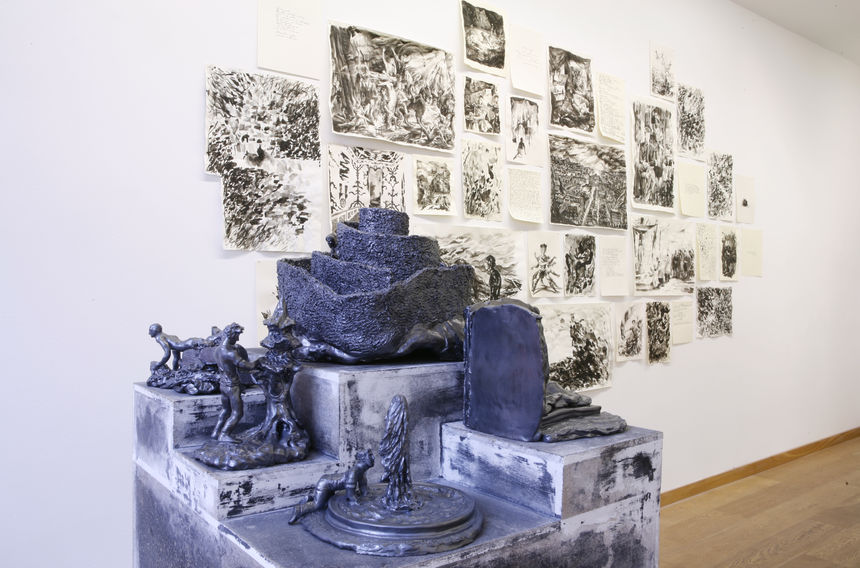Exhibition view: LIEU DE DRAGUE by Andreas Chwatal
DE
JO VAN DE LOO freut sich, Ihnen mit der Ausstellung Lieu de Drague neue Arbeiten von Andreas Chwatal zu präsentieren. Andreas Chwatal wurde 1982 in Regensburg geboren und studierte bei Markus Oehlen an der Akademie der bildenden Künste in München. 2014 wurde er ausgezeichnet mit dem Paris-Stipendium an der Cité International des Arts, wo auch ein Großteil der Arbeiten aus Lieu de Drague enstanden ist. Zahlreiche Ausstellungen im In- und Ausland, zuletzt bei JO VAN DE LOO und im Grand Palais, Paris.
Im Zentrum von Andreas Chwatals Serie La perspective ralentie [dt.: Der Blick verlangsamt sich] befindet sich die Ansicht einer Stadt. Ihre labyrinthische Anlage wird von einer Achse durchzogen, die bis zum Horizont reicht. Sichtachsen gliedern Städte, machen sie übersichtlich und beschleunigen damit den Blick.
Dennoch kann man sich kein rechtes Bild von dieser Stadt machen: Der Betrachter steht neben hohen Bäumen, links im Hintergrund sieht man Berge, rechts reicht die Bebauung ins Unendliche. Die Grenze zwischen Stadt und Landschaft verschwimmt und auch im Stadtraum ist wenig eindeutig: Ist die Ruine verfallen oder schon als solche gebaut worden? Brennt hinter ihren Fenstern Licht oder ist das die Sonne? Herrscht in dieser Stadt überhaupt Tag oder Nacht? Der Blick verlangsamt sich.
Text: Tillmann Severin
EN
JO VAN DE LOO is pleased to present the exhibition Lieu de Drague with new works by gallery artist Andreas Chwatal. The artist was born in Regensburg in 1982 and studied with Markus Oehlen at the Academy of Fine Arts in Munich. In 2014, he was awarded the Paris Scholarship at the Cité International des Arts, where a large part of the works from Lieu de Drague were created. Andreas Chwatals works were shown in numerous national and international exhibition, most recently at JO VAN DE LOO and the Grand Palais, Paris.
At the heart of Andreas Chwatal's new series La perspective ralentie [Eng: The gaze slows down] is the city. Its labyrinthine layout is traversed by an axis that reaches to the horizon. Visual axes divide cities, make them clear and thus accelerate the view.
Nevertheless, it is impossible to get a clear picture of this city: The viewer stands next to tall trees, mountains can be seen in the background, and buildings extend into. The boundary between city and landscape is blurred and even in the urban space there is little clarity: Is the ruin dilapidated or has it already been built as such? Is there a light burning behind the windows or is it the sun? Is it day or night in this city at all?
Text: Tillmann Severin
















